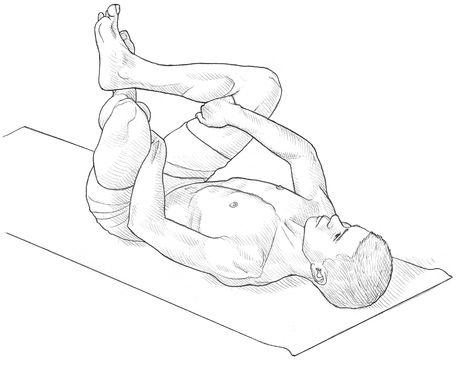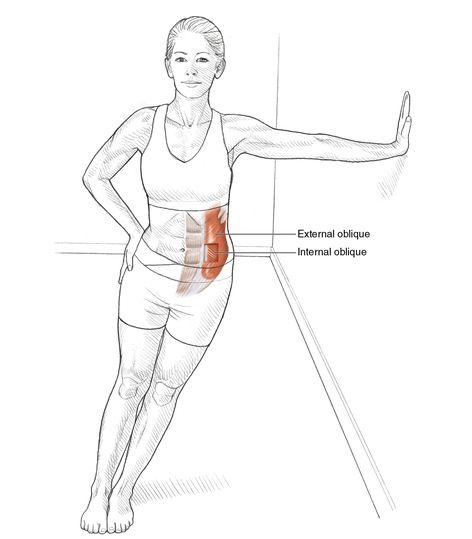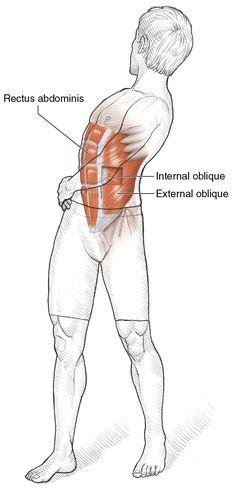Stretching Anatomy-2nd Edition (13 page)
Read Stretching Anatomy-2nd Edition Online
Authors: Arnold Nelson,Jouko Kokkonen
Tags: #Science, #Life Sciences, #Human Anatomy & Physiology

Angling the head toward one of the knees will increase the stretch on the lower-trunk extensors and partially stretch some of the lateral flexors. Sit upright in a chair, with legs separated. Slowly extend the upper back and lean forward. As you lean forward, continue to bend at the waist and lower your head and abdomen toward the right knee. Finally, slowly lower the head below the right knee. Repeat toward the left knee.
Reclining Lower-Trunk Extensor Stretch
Execution
- Lie on the back with the legs extended.
- Flex the knees and hips, bringing the knees to the chest.
- Cross the feet at the ankles, and separate the knees so they are at least shoulder-width apart.
- Grasp the thighs inside of the knees, and pull the legs down to the chest.
Muscles Stretched
- Most-stretched muscles:
Iliocostalis lumborum, multifidus - Less-stretched muscles:
Interspinales, rotatores, spinalis thoracis
Stretch Notes
Some people find that when they are performing the seated lower-trunk extensor stretch, they cannot lean forward slowly without contracting the back muscles. Keeping the muscles contracted while performing a stretch greatly reduces the effect of the stretch. Since the legs can weigh less than the trunk, these people may find it easier to perform this stretch while reclining. Also, since hyperflexion can injure the spinal cord, this stretch may be safer than the seated lower-trunk extensor stretch. When doing the reclining lower-trunk extensor stretch, it is easier to go slowly and not let the back straighten. By bringing the legs to the chest, you can easily raise the buttocks off the floor and prevent a straight back by allowing the spinal column to curl. Finally, do not try to bring the knees too far below the chest (do not try to touch the knees to the floor), as this could negate the safety benefits of this stretch.
Beginner Lower-Trunk Lateral Flexor Stretch
Execution
- Sit upright in a chair.
- Interlock the hands behind the head, with the elbows in a straight line across the shoulders.
- While keeping both elbows back and in a straight line, laterally flex the waist and move the right elbow toward the right hip.
- Repeat these steps for the opposite side.
Muscles Stretched
- Most-stretched muscles:
Left external oblique, left internal oblique, left rotatores - Less-stretched muscles:
Left intertransversarii, left multifidus, left quadratus lumborum
Stretch Notes
Research has shown that the inability to do lateral flexion is a risk indicator for recurrent nonspecific low-back pain and injuries. Also, athletes who perform overhead actions for maximum distance or force, such as baseball players, football quarterbacks, and javelin throwers, need loose lateral flexors. They are also important for overhead hitting (e.g., racket-sport serves and smashes) and when reaching up as high as possible (e.g., rebounding a basketball or spiking a volleyball). Gymnasts, modern and ballet dancers, and divers need these muscles to be loose. In addition, tight lateral flexors can lead to a form of scoliosis. The quadratus lumborum’s only action is lateral flexion, and tightness in this muscle results in a loss of lateral stability of the spine, causing the spine to curve to the left or right.
Flexing or extending at the waist will reduce this stretch’s effectiveness. Also, keep the buttocks and thighs in complete contact with the chair. The closer the elbow gets to the floor, the harder it will be to remain seated in the chair. Wrapping the lower legs and feet around the chair legs will help keep the buttocks and thighs in contact with the seat.
Intermediate Lower-Trunk Lateral Flexor Stretch
Execution
- Stand upright with the feet together and the left side of the body facing a wall about an arm’s length away.
- Place the palm of the left hand on the wall at shoulder height. Place the heel of the right hand at the hip joint.
- While keeping the legs straight, contract the buttocks and slightly rotate the hips in toward the wall.
- Use the right hand to push the right hip toward the wall.
- Repeat these steps for the opposite side.
Muscles Stretched
- Most-stretched muscles:
Left external oblique, left internal oblique, left rotatores - Less-stretched muscles:
Left intertransversarii, left multifidus, left quadratus lumborum
Stretch Notes
Many sports rely on lateral trunk flexion. Since many of these activities stress one side of the body more than the other, it is easy for the two sides of the body to become unbalanced. The active side can become tight from being overworked. If the nonworking side goes unused for extended periods, the muscles can become short. Unbalanced body sides also can result from heavy lifting, especially if one side is substantially stronger, or from participation in activities such as martial arts and football in which the body receives heavy blows. This exercise is better suited than the basic lower-trunk lateral flexor stretch for restoring flexibility because the person is in a standing position similar to the detailed sports activities.
It is very easy to lose balance while doing this exercise, so stand on a nonskid surface. Keep the left arm straight, but do not lock the elbow. You can increase the amount of stretch by moving the feet farther from the wall, by resting the left forearm instead of the hand on the wall, or both.
Advanced Standing Lower-Trunk Lateral Flexor Stretch
Execution
- Stand upright with legs 2 to 3 feet apart (60 to 90 cm), with the right foot about 1 foot (30 cm) ahead of the left foot.
- Place both hands near the right hip.
- Slowly arch the back, contracting the buttocks and pushing the hips forward.
- As you continue to arch the back, rotate the trunk to the left and drop the head back toward the right side.
- Slide the hands past the right buttock and down the right leg.
- Repeat these steps for the opposite side.
Muscles Stretched
- Most-stretched muscles:
Rectus abdominis, left external oblique, left internal oblique - Less-stretched muscles:
Left quadratus lumborum, left psoas major, left iliacus, left rotatores, left intertransversarii
Stretch Notes
This exercise is potentially dangerous, especially for people with a swayed back or weak abdominal muscles. This exercise can worsen a swayed back and cause excessive squeezing of the spinal discs, jammed spinal joints, and pinched spinal nerves emerging from the lumbar vertebrae. This stretch is recommended only for those who are very stiff and do not have a swayed back. Also, you should use this exercise only when the other lower-back flexor stretches do not provide any improvement. When doing this stretch, do minimal arching and make sure you squeeze the buttocks during the arching. Squeezing the buttocks reduces the stress on the lower back. Finally, it is very easy to lose balance while doing this exercise, so take extra care.
Chapter 5
Hips
The pelvic and the femur bones form the skeletal structure in the hip region of the body. The head of the femur bone fits into the acetabular fossa, a socket on the pelvis, to form the hip joint. This ball-and-socket joint allows the widest range of motion in the body. The movements of this joint include flexion, extension, abduction, adduction, and internal and external rotation of the hip. Surrounding the hip joints are several large and strong muscle groups, making possible the major movements of the lower extremities that are necessary for our daily activities.
Multiple muscles as well as several important ligaments surrounding the hip joint provide strong support. The ligamentum teres ligament connects the head of the femur and the acetabular notch of the pelvis to keep them together. The iliofemoral, ischiofemoral, and pubofemoral ligaments give extra support so that the head of the femur stays in the acetabular fossa in a firm, snug, and tight formation during all daily activities. The acetabular labrum runs along the rim of the acetabular fossa to deepen the hip cavity, thus giving additional support to the hip joint. All these structures combine to protect the hip joint and make it quite strong and able to withstand the demands of constant muscular movements.





